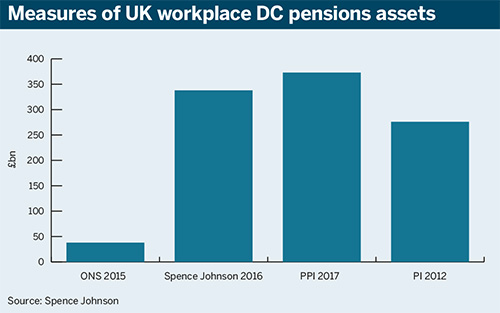Magnus Spence from research specialists Spence Johnson gives an update on the estimated size of the workplace defined contribution scheme market.
It remains a constant source of amazement to us that we and others like us have to do this job. You would have thought that this pool of assets is so important to the future welfare of the UK that the government would be willing to use its privileged position as regulatory data-collectors to create a definitive measure, but it does not.
You would have thought DC assets are so important to the future welfare of the UK that the government would be willing to create a definitive measure, but it does not
So, in market data terms we compare very poorly with other DC markets such as the US and Australia.
In fairness, there has been a development in 2017: the Office for National Statistics now says it is working on developing comprehensive measures of DC assets, so we may eventually get what we need.
In the meantime we are expected to use the existing ONS measure of DC assets released in 2017, which is that in the UK “2015 DC pension entitlements in S.129 pension funds” consists of just £38bn. In case you missed it, this is a whopping £300bn less than we have stated above.
If you are sufficiently patient and knowledgeable about the jargon in this rather specialised field to interpret the complexities of the relevant publication, you can eventually work out that this ONS measure in fact reflects just one small part of the DC market.
It excludes contract-based pensions, mastertrusts, hybrid schemes and small self-administered schemes with less than 12 members, and, I believe, does not adequately reflect very large scheme growth.
And so we are forced to conclude that the ONS contribution is unhelpful at best and confusing at worst. It would be on a par with offering a measure of UK tax revenues that then went on in an obscure footnote to say that this excluded, say, income tax, VAT and corporation tax.

We are sorry to say that the ONS does not have a great record here, since in the past it has blended annuity-related assets (decumulation) with DC (accumulation) assets to form a rather confusing measure of DC, without making it obvious this was the case.
Before this, the ONS and other government departments have confused us further by blending defined benefit and some DC pension assets into something they have persisted in calling ‘occupational pensions’ – and this cocktail of numbers is of little use to anyone as far as we can see.
For us, and all the many others keen to make head or tail of what growth is taking place in DC savings, it continues to be a lengthy detective exercise.
Since the Financial Conduct Authority does not give any indication of the DC contract-based assets it regulates, data has to be collected direct from the large pension providers and DC schemes.
Of course we also monitor the conclusions that others reach on the size of the market, but there are in fact only a few of these that we are aware of: the Pensions Policy Institute estimates that there are DC assets of £373bn in 2017.
The Pensions Institute in 2012 estimated that there were assets of £276bn; and consultancy firm Willis Towers Watson publishes measures that allow us to calculate its total of $516bn (£382bn) in DC pensions in the UK, but it does not provide a sterling equivalent nor an exact definition of what it means by DC. If you know of any other measures, please do let me know.
Magnus Spence is managing director of Spence Johnson, a Broadridge Company














